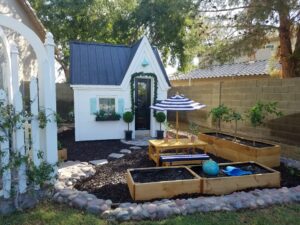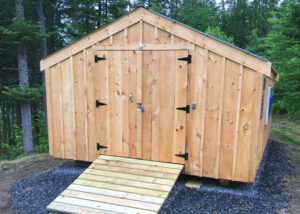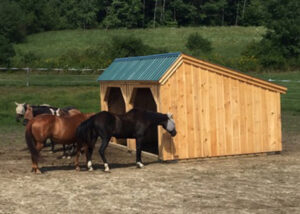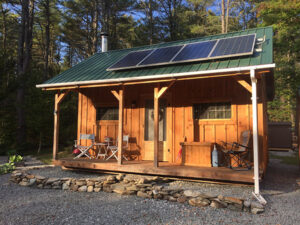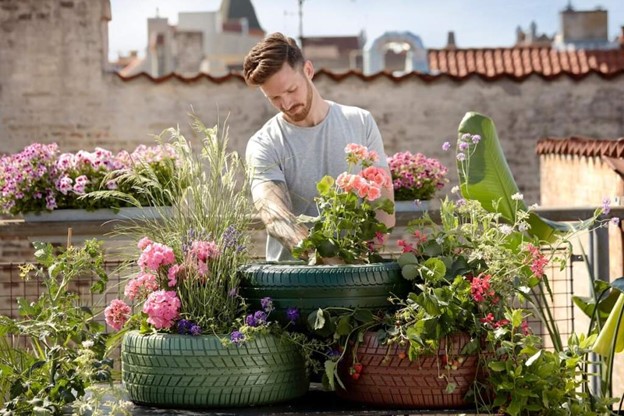
There are many ways to give back to the planet. Recycling, eating less meat, and reducing water and electricity consumption are all great ways to make your carbon footprint smaller. Have you ever thought about how your garden could better for the environment? Having a garden seems so inherently earth friendly, some don’t immediately consider it as a great space to improve sustainability. But not every garden is created equal when it comes to working in harmony with Mother Nature. Here are a few additional considerations for how to grow a beautiful, sustainable, and environmentally friendly garden.
Water Works
Keeping your lawn, flowers, and vegetables hydrated is one of the most important tasks for garden care. Make sure you’re not overwatering though. Using a lot of water from your hose can make your gardening efforts less eco-friendly. Many areas even have restrictions on water usage for yards and gardens. Here are a few ways to help you use your water more efficiently.
Use a Rain Barrel: If you live somewhere with relatively frequent rain, you can set up rain collection barrels to gather fresh water for your lawn and garden. Using collected rainwater is wonderful for your plants, and reduces your carbon footprint by decreasing the demand for treated water. Make sure that your barrels are covered using a lid or a screen that will prevent mosquitos from breeding in the standing water and keep little critters from falling in.
Plant Selection: This is especially important if you live in warmer climates. Although that beautiful Kentucky Bluegrass makes for a lush lawn, it needs tons of water. If you’re located somewhere prone to drought, consider a lawn of Bermuda, St. Augustine, or Centipede grass, which have better drought tolerance. Groundcovers can also be a great low-maintenance solution. Plants like Creeping Jenny, Ornamental Grasses, Japanese Sweet Flag, Evergreen Moss, and Clover are included in long lists for eco-friendly grass alternatives. When thinking about flowers, research what plants are native to your region – they will often need less extensive care and watering than non-native species. If you live somewhere REALLY hot and dry, consider a xeriscaped yard of beautiful cacti and succulents.
Make the bed: adding mulch to your garden and lawn is a great way to help your flower and vegetable beds retain moisture. This way you don’t need to water as much. If you’re trying to be earth friendly, be sure to pick your mulch carefully. Some types of mulch are more earth friendly than others— such as cypress mulch which isn’t particularly sustainable. Eucalyptus or coconut husk mulch are examples of more earth-friendly options.
Materials Matter
Choosing the right tools, fertilizer, and other gardening goodies can also make for more earth-friendly landscaping.
DIY Compost: It’s no secret that flowers and vegetables need fertilizer. Commercial fertilizers are typically made from unsustainably sourced ingredients. For example, phosphorous is very often imported from strip mines abroad, which means it is far from carbon-neutral. You can make your own fertilizer by composting your lawn clippings, leaves, and food scraps! Over time, these organic materials will break down into nutrient-rich soil that your plants will love!
Equipment and Storage: New electric-powered lawn mowers can be a great option for more sustainable lawn care, and are often easier to operate and maintain than gas-powered models. And of course, when you’re looking for a place to store all your equipment, picking a garage or shed made of sustainable materials like natural lumber is a best practice. Plus, natural wood buildings have a distinct beauty to them that metal or plastic sheds just can’t imitate
Reduce, reuse, recycle: Don’t be so quick to go out and buy new plastic pots for your plants. You’ve probably got tons of stuff laying around your house that you can turn into earth-friendly gardening supplies. If you’re starting plants from seeds, use paper egg cartons filled with soil to act as tiny, biodegradable pots. Extra lumber you have laying around can be turned into raised flower beds or flower boxes for your windows. Bamboo skewers or wooden chopsticks can be used as garden markers, or stakes to prop up smaller plants.
Plant Power
The types of plants in your garden can also influence its environmental impact. garden. Choosing species that are adapted to your climate is, again, a wise choice for reducing water consumption and ensuring a happy garden. There are tons of other benefits to consider when carefully choosing what greens you grow!
Companion Planting: Just like people, plants need friends too. Certain species of plants grow very well in the company of others and can reduce the need for pesticide and fertilizer use. Taller crops also provide shade for more delicate plants, and reduce evaporation from the soil, meaning you can use less water. There are many resources online that you can reference to find out which flowers and vegetables thrive in the company of others
Pollinator Paradise: If you’re growing fruits and vegetables, you’ll certainly want to attract pollinators to your yard. The best way to do this is to provide them with food. Build a flowerbed or box that is filled with flowers that are native to your region: you can find wildflower seed mixes that will do just the trick. Making sure the bees and butterflies are well-fed is good for nature as well. There are many trees, shrubs, and wild plants that rely on our local pollinators to thrive.
Down to Earth: Did you know that some plants enrich the soil as they grow? Nitrogen-fixing plants such as beans and peas have a unique ability to synthesize their own nitrogen, even returning some to the dirt where they are growing. If you rotate your flowerbeds every year with a nitrogen-fixing plant species, you’ll keep your soil healthy and reduce your need for fertilizer.
These are just a few useful tips for you this growing season! Don’t feel discouraged if some of them are difficult, out of reach, or not practical for your specific situation. When it comes to reducing our environmental impact, it’s best to start small. If you’re just getting started or considering change, try at least a couple of these tips out. Ensure your garden is sustainable, not only environmentally, but sustainable and beneficial for you as its keeper too. The best sustainable garden tip is going to be one that is maintainable and suits your goals. Little by little, you can become a total pro at Earth-friendly, sustainable gardening.


